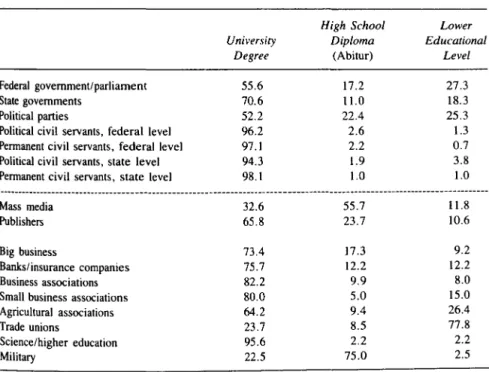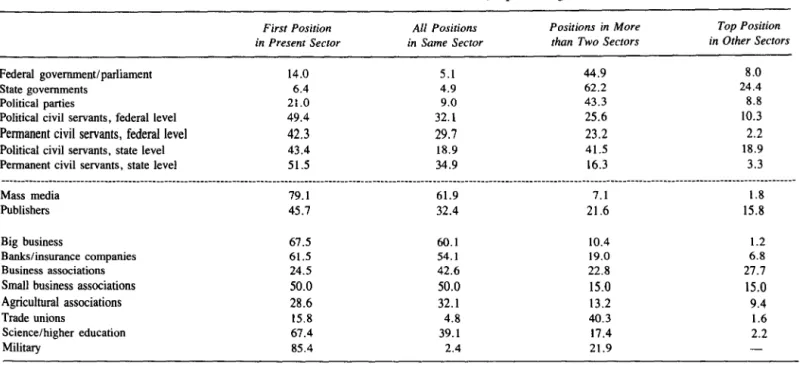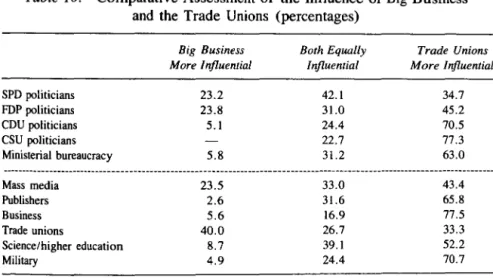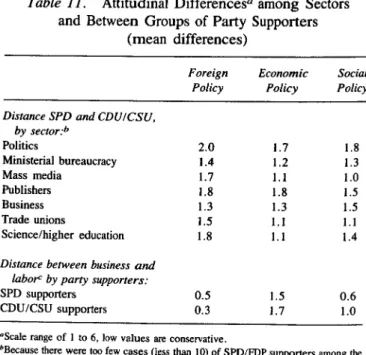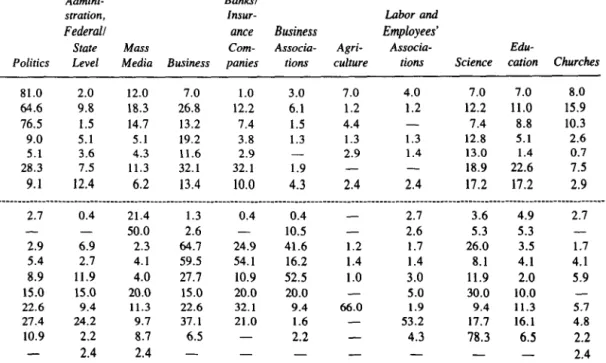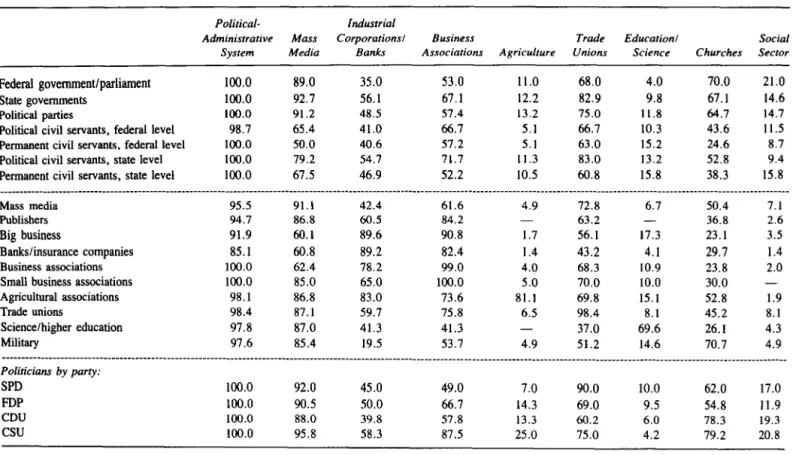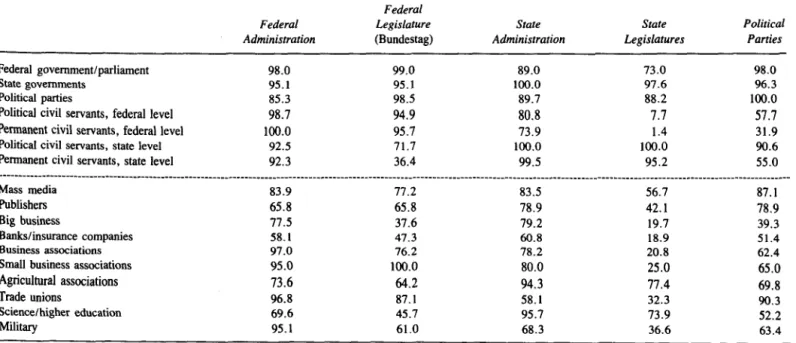CONFLICT AND CONSENSUS
AMONG ELITES IN THE FEDERAL REPUBLIC OF GERMANY
Ursula Hoffmann-Lange, Helga Neumann, and Bärbel Steinkemper
THE ROLE OF ELITES IN PLURALIST DEMOCRACIES
In Western democracies the theory of plural ist democracy is widely used as a model of the process of opinion and policy formation. In its classic version, this theory was conceived as a participatory model whose central variables were multiple group memberships and the concept of cross-pressures. V. Pareto, G.
Mosca, M. Ostrogorski, and R. Michels, however, earlier contended that the
"masses" are unable to rule themselves and that the existence of elites or ruling classes is universal. Later, the results of empirical political research also called into question the validity of the assumptions of the classic theory of pluralistic
Research in Politics and Society, Vol. 1, pages 243-283 Copyright © 1985 by JAI Press Inc.
AU rights of reproduction in any form reserved.
ISBN: 0-89232-335-3
243
244 u. HOFFMANN-LANGE, H. NEUMANN, and B. STEINKEMPER democracy with regard to the number and meaning of multiple group mem- berships, the extent of active political participation, and the existence of a broad consensus on basic values and the "rules of the game" within the general population.
In the "realistic" theory of democracy, therefore, instead of individuals and groups, it is the elites who are considered to be the main political actors in the processes of interest articulation and policy formation. Thus, modem pluralist theory and elite theory both agree "that leadership groups and their interre- lationships are the theoretical key to the explanation of political behavior" (Bal- bus, 1975:237). There is, however, no agreement between these two schools of thought concerning the nature and composition of elites or the limitations set on elite actions by the social structure. While power elite theorists assume a some- what oversimplified relation between economic status and political power, the pluralists have neglected the impact of socioeconomic and institutional structures on the policy formation process.
In the following, starting with abrief description of the structural features of the social and political system,
Iwe will investigate the nature of elites in the Federal Republic of Germany, as weIl as the opportunities for cooperation and conflict among different elites. The first part will be devoted to the analysis of the social distances between elite groups, i.e., background and career differences which can create barriers to intersectoral communication and thus lead to diffi- culties in reaching agreement on collective decisions within the elites.
In the second part, investigating the political beliefs of elites, we want to show the main cleavage lines within the elites. In a pluralist society, such conflicts of interests or values must be considered as normal. Their rational settlement re- quires, however, the acceptance of certain rules of the game by the conflicting parties. These rules normally include the acceptance of political institutions such as general elections, party competition, and the majority principle, i.e., the general willingness to cooperate and compromise with competing groups in a pluralist process of policy formation. Therefore, we shall also investigate whether such a consensus on the mIes of the game exists within the West German elite.
Given the decline of traditional patterns of ruling class homogeneity based on social ties and homogeneous political outlooks, we assume that more fonnalized interactions such as multiple position holding and role-related contacts to a wide range of organizations prevail among modem elites. These will be analyzed in the last part of the paper.
DEFINING LEADERSHIP GROUPS IN THE FEDERAL REPUBLIC
We shall try to answer the questions raised above by analyzing the data of an elite
survey carried out in 1972.
2Like previous empirical studies on national elites in
the Federal Republic this study proceeded from a positional approach defining
Conjlict and Consensus Among Elites in West Germany 245 the elites as holders of top positions in the most important organizations of society, (Edinger, 1960; Deutsch and Edinger, 1959; Zapf, 1965; Wildenmann, 1968; Enke, 1974; Roth, 1976). This implies the assumption that power is organized in tenns of division of labor. As a first step it requires the identifica- tion of relevant organizations, an undertaking which is, however, not without problems. In doing this "one has to rely on what overall knowledge one has of the system under investigation. There is no question that an ample portion of arbitrary judgment is involved as long as sound theories of the system' s structure and behavior are lacking." (Schleth, 1971:103). Zapf, reviewing the different approaches to solving this problem in a theoretically and analytically coherent fashion, comes to the concIusion that they all have proved to be inadequate and that Iists of groups and positions' 'which have been drawn up by informed social scientists using their considered 'judgment' " have worked best (1965:68).
For the purpose of the survey of 1972 three main sectors were identified: the private sector, the mass media, and the political-administrative sector. In the private sector, those subsectors and organizations were selected which have the greatest potential for the organization and assertion of special interests, i.e., business, business associations, and trade unions. The mass media were included because of the crucial role they play in the opinion-formation process. In West Gennany, the press and the broadcasting media as two distinctive subsectors are organized in two different ways: the press on a private enterprise basis and the broadcasting media on the basis of support from public bodies financed by govemment-regulated revenues, (i.e., fees paid by the consumers), and con- trolled by boards composed of representatives of major organizations of the private sector such as political parties, churches, and other voluntary associa- tions. The political sec tor was represented by position holders in the federal and state administrations , 3 legislatures, and political parties as weIl as the civil service and the military. After having identified all relevant position holders they were asked for an interview. The overall response rate was 60.2 percent.
In the following, we give abrief description of the composition of the different elite groups ("sectors ") whieh were included in the analysis:
• Federal government andfederal parliament (Bundestag) (n = lOO)-cabi- net members and junior ministers within the federal govemment; chairmen and deputy chairmen of permanent committees, parliamentary party groups, and permanent working groups of the parliamentary parties within the Bundestag; spokesmen of the parliamentary party groups for the differ- ent poliey areas
• State governments (n = 82)-all cabinet members
• Political parties (n = 68)-members of the national eommittees of the political parties represented in the Bundestag (CDU, SPD, FDP), as weIl as the ehainnen and deputy chairmen of these parties on the state level (in- cluding the CSU)
• F ederal political civil servants (n = 78)-administrative heads
(Staatssekretäre) and department heads of federal ministries
246 U. HOFFMANN-LANGE, H. NEUMANN, and B. STEINKEMPER
• Permanent federal civil servants (n = 138)-subdepartment heads in federal ministries; heads of the most important federal agencies
• State political civil servants (n = 53)-administrative heads of state ministries
• Permanent state civil servants (n = 209)-department heads in state ministries
• Mass media (n = 224)-managing directors, program directors, editors- in-chief, and heads of politically relevant departments of the broadcasting stations (n = 94); the editors-in-chief and heads of political and economic desks of daily and weekly newspapers with a circulation of at least 100,000 copies and those of leading magazines (n = 130)
• Publishers (n = 38)-publishers and managing directors of the news- papers and magazines in the above categories
• Big business (n = 173)-leading members of the executive boards, chairmen and deputy chairmen of the boards of directors of the largest business corporations (industry, trade, service)
• Banks and insurance companies (n = 74)-leading members ofthe execu- tive boards, chairmen and deputy chairmen of the boards of directors of the largest financial corporations
• Business associations (n = IOl)-chairmen or presidents and their depu- ties as weIl as managing directors of the federal top associations of business
• Small business associations (n = 20)-presidents and vice-presidents as weIl as managing directors of the federal associations of small business enterprises such as crafts and retail trade
• Agricultural associations (n = 53)-presidents or chairman and their dep- uties as weIl as managing directors of the agricultural associations at the federal and state level
• Trade unions (n = 62)-chairmen and their deputies as weIl as managing directors of federallabor associations, Le., the leading position holders in the top association and the member unions of the DGß (German Trade Union Federation) and the DAG (German white-collar employees union)
• Science and higher education (n = 46)-presidents of universities (Rek- toren), as weIl as the chairmen and managing directors of the biggest research organizations and science foundations
• Military (n = 41)-position holders in the highest echelons of the military hierarchy (generals and admirals)
ELITE RECRUITMENT
The differentiation of modem industrial societies and the resulting autonomy of
different sectors make communication and cooperation between various group
representatives more difficult. Formerly, social homogeneity made communica-
Conflict and Consensus Among Elites in West Germany 247 tion and cooperation easier between segmented groups by means of a "common language" (Dahrendorf, 1965; Edinger and Searing, 1967).
Sodal Profiles
Since the beginning of this century the characteristics of the Gerrnan lead- ership dass have changed noticeably (Zapf, 1965). This change was caused in part by the two world wars-especially by World War II-and their conse- quences, such as the breakdown of the economy and a massive population displacement which blurred the traditional lines of social deavage (Lepsius, 1974), quite apart from the elimination ofleadership personnel (i.e., the nobility and large landowners). A second important contributing factor was the develop- ment of the Federal Republic of Germany into a modem industrial society with its changing requirements as to the number of leaders needed as weH as their specialized qualifications; today, criteria of achievement are stressed more than intimate ties.
Despite the disintegration of the traditional dass structure, membership in a particular social stratum is still significant from the standpoint of either a com- mon or dividing socialization. An analysis of the social status (or dass mem- bership) of incumbents of top leaders hip positions documents a shift in the basis of recruitment from a pattern of predominantly upper-dass recruitment to a stronger representation of the middle dass (Lepsius, 1974:180): almost two- thirds of the respondents came from a middle or lower-middle-dass background (Table I).
Within the elite sectors certain concentrations can be seen. Thus, the scien- tific-educational and military sectors as weH as the business associations are disproportionately recruited from the upper dass (between 40 and 49 percent).
The portion coming from the lower dass is disproportionately high among trade union leaders (16.7 percent), as is to be expected, but also among Bundestag leaders, where a substantial proportion are of lower-dass origins. This is mainly due to the SPD members of Parliament: whereas the CDU/CSU and the FDP parliamentary parties are, in terms of dass origins, concentrated in the lower middle dass (50.0 and 55.6 percent, respectively) and draw hardly at aH from the lower dass, one-quarter of the SPD parliamentary leadership group are of lower- dass origins and only about one-third (34.3 percent) come from the lower middle dass. Similar social background patterns were found among the state govem- ment and the party elites.
By and large, the social distances among the majority of the members of the elite have shrunk; this tendency is strengthened by the fact that most of the sectors are relatively heterogeneous in their recruitment pattern. Nevertheless, entry into leadership positions for persons of lower-dass origins is largely re- stricted to trade unions and the SPD.
To be sure, the family's social status determines to a large degree the kind and
248 U. HOFFMANN-LANGE, H. NEUMANN, and B. STEINKEMPER Table 1. Social Class OriginG (percentages)
Upper Upper Middle Lower Middle
Class Class Class Lower Class
Federal governmentlparliament 19.3
b25.0 44.3 11.4
State govemments 26.1 21.7 42.0 10.1
Political parties 23.7 22.0 45.8 8.5
Political civil servants, federal level 29.9 38.8 28.4 3.0
Pennanent civil servants, federallevel 36.0 32.4 29.7 1.8
Political civil servants, state level 34.1 34.1 27.3 4.5
Pennanent civil servants, state level 33.0 35.1 28.2 3.7
---._---
Mass media 30.9 23.4 38.9 6.9
Publishers 32.3 35.5 29.0 3.2
Big business 32.7 28.7 34.7 4.0
Banks/insurance companies 34.4 26.6 35.9 3.1
Business associations 48.9 25.6 23.3 2.2
Small business associations 62.5 31.3 6.3
Agricultural associations 14.0 20.9 60.5 4.7
Trade unions 3.7 11.1 68.5 16.7
Science/higher education 46.2 33.3 20.5
Military 48.6 28.6 20.0 2.9
aTbe classification is based on the Kleining-Moore Scale [Kölner Zeitschrift für Soziologie und Sozialpsychologie 12(1960):86ff.; 20(l968):502ff.l, modified by the level of father's education.
bPercentaging on the basis of c1assifiable responses. The percentage of c1assifiable responses was, on Ihe average, 85%.
extent of the education of their children; modem industrial societies require abilities and knowledge which can be acquired only by means of extensive education and on-the-job-training. Consequently, today, a formal education is a prerequisite for entry into leadership positions. Since this applies to all sectors, we did not expect to find large educational differences among the individual sectors; the data in Table 2 confirm this hypothesis.
Usually the education level of elites is very high: about two-thirds of the leaders graduated from a university, in contrast to only three percent of the general population. This means that a large part of the leadership personnel have attended similar educational institutions and have intemalized the same or similar norms. This process influences individual communication patterns: as long as a high formal level of education is generally recognized as a recruitrnent mecha- nism, this standard will also be applied to partners and opponents in the political interactional process. An equally high educational level in all elite groups can thus reduce communication barriers that resuIt from differences in dass origin.
A high level of formal education has always been characteristic of the top
Canflict anti Consensus Among Elites in West Germany
Table 2. Educational Level (percentages)
Federal govemment/parliament State govemments
Political parties
Political civil servants, federal level Pennanent civil servants, federal level Political civil servants, state level Pennanent civil servants, state level Mass media
Publishers B ig business
Bankst insurance companies Business associations Small business associations Agricultural associations Trade unions
Science/higher education Military
University Degree
55.6 70.6 52.2 96.2 97.1 94.3 98.1 32.6 65.8 73.4 75.7 82.2 80.0 64.2 23.7 95.6 22.5
High Schaol Dip/oma
(Abitur) 17.2 11.0 22.4 2.6 2.2 1.9 1.0
55.7 23.7 17.3 12.2 9.9 5.0 9.4 2.2 8.5 75.0
249
Lower Educationa/
Level 27.3 18.3 25.3 1.3 0.7 3.8 1.0 11.8 10.6 12.2 9.2 15.0 8.0 26.4 77.8 2.2 2.5
administrative positions because of the statutory formal entry requirements; quite obviously this also applies to the representatives of the scientific-academic group-almost exclusively professors-who are correspondingly homogeneous.
In addition, the economic elites have supplemented the managerial criteria of initiative, willingness to take risks, and managerial abilities with academic stud- ies (Kruk, 1972:73).
Three groups in particular deviate noticeably from the norm of a high level of formal education: union leaders, joumalists, and military leaders. But even in these three groups the level of education rose during recent decades (Zapf, 1965). This also applies to politicians, whose level of education is somewhat below the overall elite average. A breakdown by party reflects the earlier social background findings: compared to 73.5 percent of university graduates among CDU/CSU leaders and 57.5 percent among FOP leaders, of the SPD politicians only 46.2 percent are university graduates.
In summary, the West German elite is not homogeneous, at least with regard
to class origins and education. Some concentrations were detected in the indica-
tors selected; however, in general, the sectors are too heterogeneous to assume
patterns of specific and autonomous social recruitment. The social background of
top position incumbents is thus relatively neutral as far as the interaction among
250 U. HOFFMANN-LANGE, H. NEUMANN, and B. STEINKEMPER groups is concemed-that is, it neither strengthens the communication barriers due to the division of labor nor contributes to the reduction of existing barriers due to the lack of social homogeneity.
Religious ties have traditionally been a part of elite sociaI background analy- sis, since they may contain a potential for conflict on questions which concem the vaIue system of a society. The religious c1eavage was for a long time an important characteristic of Gennan social structure which led to social and politi- cal tensions (Lepsius, 1974). This situation was reflected by the underrepresenta- tion of Catholics among the political, administrative, economic, and cultural leadership of Germany since the founding of the German Empire in 1871 (Lep- sius, 1974; Zapf, 1965; Peisert, 1967). In the overall elite sampIe 56 pereent belonged to the Protestant church and 28.5 percent to the Catholic chureh, compared to 49 percent and 44.6 percent in the West German population.
A relatively balanced relationship (Table 3) between Protestants and Catholies is found in the Bundestag sampIe (47.3 percent Protestant, 44.0 percent Catho- He), which is a result of the overrepresentation of Catholics in the CDU/CSU (56.1 percent). In the federal administration-among both political and perma- nent civil servants-the number of Catholics has increased; this is due in part to the previous CDU/CSU govemments and the "religious proportionality arith- metic" (i.e., Protestant-Catholic balance) wh ich they practiced in top civil
Table 3. Church Membershipa (percentages)
No Religious Protestant Catholic Affiliation
FedernI govemmentlparliament 49.0 41.0 9.0
State govemments 52.4 26.8 18.3
Political parties 57.4 22.1 20.6
Political civil servants, federal level 56.4 39.7 3.8
Pennanent civil servants, federallevel 57.2 34.1 8.7
Political civil servants, state level 73.6 17.0 9.4
Pennanent civil servants, stale level 65.9 29.3 4.3
--- .. ---
Mass media Publishers Big business
Banks/insurance companies Business associations Small business associations AgriculturaI associations Trade unions
Science/higher education Military
47.8 47.4 57.2 50.0 76.2 65.0 66.0 40.3 67.4 68.3
30.4 34.2 26.0 29.7 16.8 25.0 32.1 32.3 19.6 24.4 aMembership in other churches was mentioned by only nine respondents (0.6%)
21.4
18.4
16.2
18.9
10.0 5.9
27.4 1.9
13.0
4.9
Conflict and Consensus Among EUtes in West Germany 251 service and other appointments; the number of Catholics in the trade union elite results from the existence of specifically Catholic labor organizations.
However, it should be noted that there are scarcely any religious cleavages in the West German population today which could be transmitted into the elite stratum. Moreover, the church has lost significance as a value-setting institution.
This is shown by the fact that a federal govemment was elected which is not viewed as one which represents religious interests (Kaltefleiter, 1973:95). The growing number of incumbents of top positions without church membership- which, at almost 13 percent, is twice as high as in the West German population (about 6 percent)-likewise supports this assertion.
Professional Recruitment
The following considerations are based on the assumption that the behavioral potential of a person is determined largely by the intemalization of professional norms or role expectations-a hypothesis which is supported by recent empirical studies of elite groups (Barton, 1973; Schleth, 1971; Searing, 1968/69). The dominant factor in these professional experiences is membership in a particular functional group. The intensity of this socialization process depends on the duration of the process and on the exclusiveness of such experiences.
For the different sectors this means that their behavioral potential depends on the degree of professionalization-that is, on the extent to which the careers of their members are exclusively within that professional area. The more spe- cialized the career and the more autonomous the recruitment of the sectors, the greater will be the prob ability of interelite conflict (Keller, 1968; Enke, 1974;
Eisenstadt, 1967). Whether this problem is found in the West German leadership and, if so, to what extent, will be investigated below on the basis of indicators of the sector of one's first position, careers completely in one sector, frequency of change of sector, and the extent of intersector elite circulation.
Indeed, the actual process of professional socialization begins with entry into the first professional position. To some extent, however, the "switches" are already set for starting out in a particular professional area by the choice of a specific field of training or course of academic studies. The relationship between the course of studies and the first position proves to be stronger than that between the course of studies and present elite sector membership. This indicates that the decision about a particular starting position is not equivalent to lasting ties to one sector.
Strictly speaking, one cannot take professionalization to mean that all the
positions of a respondent from the first to the present one have been held within
one sector. Concentrating, however, on the first, the most homogeneous group
seems to be the mass media elite (Table 4). The extent of self-recruitment in the
administration is surprisingly low, considering the tradition al German concept of
a career system and of the career civil servant (Laujbahnbeamten). This is so,
~
Federal governmentl parliament State govemments
Political parties
Political civil servants , federal level
Pennanent civil servants, federallevel
Political civil servants, state level Permanent civil servants , state level Mass media
Publishers Big business
Banks/insurance companies Business associations Small business associations Agricultural associations Trade unions
Science/higher education Military
Table 4. Professional Socialization Factors (in percentages)
First Position All Positions Positions in More in Present Sector in Same Sector than Two Sectors
14.0 5.1 44.9
6.4 4.9 62.2
21.0 9.0 43.3
49.4 32.1 25.6
42.3 29.7 23.2
43.4 18.9 41.5
51.5 34.9 16.3
79.1 61.9 7.1
45.7 32.4 21.6
67.5 60.1 10.4
61.5 54.1 19.0
24.5 42.6 22.8
50.0 50.0 15.0
28.6 32.1 13.2
15.8 4.8 40.3
67.4 39.1 17.4
85.4 2.4 21.9
Top Position in Other Sectors
24.4 8.0
10.3 8.8
18.9 2.2
3.3
1.8
15.8
6.8 1.2
27.7
15.0
9.4 1.6
2.2
Conjlict and Consensus Among Elites in West Germany 253 even though activities on all administrative levels, including local government, were counted as a same-sector start [see Steinkemper (1974) for a discussion of the implication of this]. Indeed, an additional II percent of the political and 23 percent of the permanent civil servants began their careers in the judiciary, i.e., in an area that is elose to that of the administration in terms of the substantive socialization process.
The low within-sector recruitment of leaders of business associations can be traced to the fact that they usually start their careers in a business enterprise, and it is only after a few years that they change to a corresponding association. If these people are added, the proportion of within-sector recruitment in this group approaches that of the industrialists (about 67 percent); however, these numbers are still lower than previous studies led us to expect (Kruk, 1972; Prass and Boetticher, 1971). In the trade unions there are comparatively fewer full-time salaried positions on the lower organizational levels, where most of the union jobs are done on a honorary basis. For this reason, trade union leaders normally begin their careers as workers or employees either in the private sector (43.9 percent) or in the public service sector (31.6 percent).
The lowest degree of professionalization is found in the political area. This is due both to the lack of full-time beginning or "learning" positions in the politi- cal subsystem and to the view that qualifications gained from a nonpolitical profession are an important prerequisite for assuming political functions or office.
The impression of relative heterogeneity of careers gained from the analysis of starting positions is confirmed by an analysis of sector change over the entire Course of professional careers (see Table 4). Only a third of the elite members held positions exelusively in one sector over the course of their entire careers; in fact, about one-quarter have been active in at least three sectors. Especially high is the number of sector changers in the political area: only 5 percent ofthe overall political elite sampie have had exclusively political careers, whereas one-half had professional experiences in at least three areas. There were only insignificant differences among the political parties.
Journalists demonstrated the greatest homogeneity, followed by economic leadership groups. In these areas, exchange mainly takes place with only one other sector; apart from this, there is little intersector exchange, even less than in the group of top civil servants. The members of the military elite stand out by their high rate of extrasector recruitment, in contrast to the high rate of within- starting positions: only 2 percent can look back on exclusively military careers, compared to about three-quarters who were active in at least one other profes- sional area; an explanation of this is that these other professional activities were often transitional positions that bridged the period between the end of the World War II and the formation of the West German armed forces (Bundeswehr).
Often taken as a further indicator of career homogeneity/heterogeneity is the
extent of elite circulation, i.e., the exchange of top position holders among the
254 U. HOFFMANN-LANGE, H. NEUMANN, and B. STEINKEMPER various sectors (Mills, 1956; Enke, 1974; Porter, 1966). Indeed, about one-third of the rnembers of the elite had previously held a top position, but only 8 percent had held one in another sector. One can thus hardly speak of a high rate of elite circulation. An exception to this general pattern is the state govemment elite, which is recruited, to a large extent, from among top civil servants, a related area. In contrast to this, election to the Bundestag takes place almost exclusively from arnong those having apreelite status. Because of the risks involved in elective political office, potential leaders on the higher rungs of the career ladder are normally lost to politics (von Beyme, 1971). Moreover, a parliamentary career has become increasingly unattractive, especially for industrialists and businessmen, since today other more effective ways of interest articulation are available [see Neumann (1979) for a discussion ofthis point]. Economic associa- tion leaders exhibit an above-average rate of elite circulation, most of which, however, involves exchange with the business sector; there, too, elite exchange takes place only between related sectors.
In summary, we can say that during a professional career, experiences are often gathered from different sectors, with considerable variations among the elite groups in the extent of intersector exchange. However, upon achieving a top position there is practically no more change, or at best, only between related sectors. When this primarily formal consideration of career structures is supple- mented by a c1assification of the specific area activities over the course of entire careers (Table 5), affinities between certain sectors are seen which can modify the results of previous studies of social and professional recruitment.
In the first place, it was found that a large majority of each group-between 70 and almost 100 percent-had already held at least one position in their present sector before their current one; as a rule, the last steps of the career ladder are within one sector. However, this does not explain anything about the time preceding this stage-whether, and to what extent, varied activities were per- formed and thereby different socialization experiences were undergone.
The political elites are recruited on the broadest base; they combine personnel from all the other groups, which supports the impression of heterogeneous career patterns that has been found in this study. The present position of almost 30 percent of the politicians is the first political office that they have held; they were previously active exclusively in other sectors. A breakdown of politicalleaders by party reveals several contrasting differences: whereas there is an above- average proportion of former civil servants among CDU/CSU leaders, the SPD has the most trade unionists, and middle-c1ass professions dominate in the FDP . . In the ministerial bureaucracy it is also seen that a large number of "out- sId~rs" rose to leading positions, many of whom had previously never been actIve in the administration. This proportion is naturally higher among political than among permanent civil servants; it is noticeably high among state ministrY
~ead~, for ab~ut one-third of whom their present position is their first admin- IstratIve functlOn. The largest group of civil servants with occupational experi-
'"
::I
o
.~
> a o
<!:: E §
·e ~
Busi- Big Small
ness Banks! Business Business! Labor Or- Science! Judiciary Admini- Mass Enter- Insur- Associa- Pro- Agri- ganiza- Higher Educa- (Without Politics stration Media prises ance tions fessionals culture tions Education tion Lawyers)
Federal govemmentlparliament 71.()b 16.0 21.0 14.0 2.0 4.0 16.0 10.0 8.0 11.0 8.0 14.0
State govemments 70.7 32.9 9.8 9.8 4.9 8.5 20.7 6.1 13.4 18.3 13.4 18.3
Political parties 76.5 16.2 14.7 16.2 4.4 22.1 4.4 10.3 8.8 11.8 14.8
Political civil servants, federal level 17.9 87.2 2.6 16.7 2.6 2.6 10.3 1.3 7.7 20.5 2.6 15.4
Pennanent civil servants, federal level 7.2 92.0 5.8 15.2 2.2 3.6 3.6 0.7 1.4 15.9 5.1 24.6
Political civil servants, state level 18.9 66.0 9.4 17.0 1.9 5.7 \3.2 3.8 7.5 20.8 9.4 18.9
Pennanent civil servants, state level 9.6 90.0 2.4 9.1 2.4 3.3 8.1 3.8 3.3 10.5 6.7 25.8
N 01
---_ .. ---_ .. ---
01
Mass media 4.0 3.6 98.2 5.8 0.9 1.3 0.4 4.0 7.6 5.4 1.8
Publishers 10.5 5.3 84.2 18.4 2.6 15.8 2.6 5.3 7.9 5.3
Big business 1.7 11.6 1.7 88.4 1.7 6.4 \6.8 \.l \.l 15.0 2.3 9.2
Banks/insurance companies 5.4 10.8 2.7 24.3 82.4 5.4 10.8 1.4 1.4 5.4 6.8 13.9
Business associations 11.9 13.9 4.0 46.5 5.9 52.5 17.8 1.0 3.0 16.8 3.0 13.5
SmaJl business associations 20.0 15.0 20.0 15.0 80.0 5.0 5.0 10.0
Agricultural associations 13.2 17.0 13.2 9.4 3.8 1.9 83.0 26.4 5.7 3.8
Trade unions 16.1 17.7 6.5 32.3 3.2 1.6 9.7 80.6 1.6 24.2 8.1
Science/higher education 6.5 13.0 4.3 26.1 4.3 6.5 8.7 100.0 6.5 4.3
Military 7.3 36.6 19.5 39.0 2.4 9.8 2.4 2.4 12.2 7.3 2.4
"Other areas were hardly mentioned, so they are not considered here. A coding of the exchange with the military area could not be done sinee it could not be determined from the responses what the exact status of the military service was, i.e., whether draftee or professional soldier. Tbe number who had military service was about the same for all sectors-between 20 and 30 percent.
bBecause of multiple responses, the totals may exceed
100%.256 U. HOFFMANN-LANGE, H. NEUMANN, and B. STEINKEMPER ence outside the administration is recruited from other areas of public service, such as science and education or justice, but a considerable group also comes from the industrial sector. Moreover, almost one-fifth of the political civil ser- vants had acquired political experience. The administration itself represents, next to business and industry, the most significant pool for all other sectors. Jour- nalists exhibit the highest degree of autonomy; they showalmost exclusively intrasector recruitment patterns and they supply few, if any, personnel to other sectors.
Business groups are recruited on a relatively broad basis. However, the afore- mentioned selection mechanism begins early and leads to comparatively homo- geneous careers-there is subsequent exchange of personnel only from big busi- ness companies to the business associations. It is striking that the business associations, as the special organized interest representation for this sector, send fewer personnel to the political and administrative areas than do big business, smal1 business, and professionals. These latter groups additionally serve as re- cruitment bases for a11 other groups.
The recruitment of union leaders is also heterogeneous, but with concentra- tions in the industrial sector and in public service (administration and education).
Few personnel are supplied to other sectors, though some go to the political elite, almost exclusively the SPD.
What significance can be attributed to these recruitment patterns with regard to communication and cooperation among the elites? The political-administrative area is placed at the center of the multiple crisscrossing professional connections.
In the political-administrative elite an understanding of the specific interests and concems of almost a11 other social groups included in this study is acquired and integrated. Barriers due to social background and education-especially in the political area-are to a great extent dismantled, so that an openness to commu- nication and cooperation on the part of both groups can be expected. However, there is a greater affinity between politicians and union leaders, on the one hand, and civil servants and business leaders, on the other (a relation that we shall discuss later). Near the edge of the elite exchange process-and therefore proba- bly also of the interactional process-are to be found the leaders of the mass media; for them, however, an independent and autonomous position seems appropriate.
In summary, with regard to either social or professional recruitment we cannot speak of a homogeneous leadership stratum. However, neither can we find the other extreme pattern of autonomous, homogeneous elites, made possible by differentiation of tasks and division of labor, which has often been postulated to exist in Germany .
POLITICAL BELIEFS
The term political beliefs is used here as a global concept under which a number
of different assessments and evaluations of specific aspects of West German
Conflict and Consensus Among Elites in West Germany 257 society and politics are subsumed. Assessment of the distribution of power, evaluations of this power distribution, support for or opposition to a number of politicaJ goals, and basic questions of the political opinion-formation process will be analyzed. Thus, our approach here will differ from that of previous sections, since more than only elite sector membership will be considered. Elite sector membership is of course an important independent variable in the forma- tion of political beliefs (e. g., Edinger and Searing, 1967), but in addition to it a second variable, the party preference of the respondents, will be investigated.
This is important in two ways. First, a relationship between elite sector mem- bership and party preference can be presumed. Second, party preference assurnes an important role with regard to specific political beliefs because, in Western democracies wh ich do not have segmented political subcultures, the dominant camps of social conflict are defined in conflicts between or among the political parties (see, e.g., Hoffmann-Lange, 1977; Lepsius, 1973; Massing, 1974).
The comparison between the party politicians and the other sectors helps to identify more party-specific conflicts in contrast to more sector-specific con- flicts, and to answer the question as to what extent the existing party system is able to transform the sector-specific conflicts into political conflicts.
Party Preference and Party Membership
Before presenting the results of the analyses, a few notes concerning the nature of the party system at the time of the survey are necessary. The reformation of the political parties after World War 11 led to a large number of parties and to a fragmentation of the party system during the first years of the Federal Republic.
Since then the party system has shrunk to three parties which together hold more than 90 percent of the seats in the Bundestag. These are the Christian Democratic Party (CDU/CSU), the CSU (Christian Social Union) being limited to Bavaria;
the liberal Free Democratic Party (FDP); and the Social Democratic Party (SPD).
On the federal level the "bourgeois" parties (CDU/CSU and FDP) were dominant during the postwar period. During the decade of the 1950s the CDU/CSU increased its share at the cost of the small splinter parties, while the electoral results for its coalition partner, the FDP, fluctuated at around 10 percent of the votes. The SPD was at first relatively weak (about 30 percent), but by expanding into a "catchall" party, it not only increased its proportion of the votes but also became an acceptable coalition partner for the other parties.
However, only between 1972 and 1976 did it hold a plurality of the seats in the Bundestag.
After internal crises in the CDU/CSU and increasing tensions in the governing
coalition of the CDU /CSU and the FDP there evolved a grand coalition between
the two large parties, the CDU/CSU and the SPD, in 1966. At this time a shift
within the FDP in favor of the social-liberal wing of the party took place. In 1969
this party formed a coalition with the SPD, in spite of a narrow parliamentary
majority. This social-liberal coalition maintained a majority in the Bundestag
258 U. HOFFMANN-LANGE, H. NEUMANN, and B. STEINKEMPER until 1982 while the CDU/CSU continued to dominate the Bundesrat (Federal Council, the second chamber ofthe legislature). In the spring of 1972, at the time when our elite survey was carried out, the political climate was especially strained: the federal government in May 1972 barely survived a vote of no confidence.
The 250 politicians interviewed in this study are distributed among the four parties as folIows:
100 SPD politicians 83 CDU politicians 24 CSU politicians 42 FDP politicians
(40.0%) (33.2%)
(9.6%) and (16.8%)4
In other sectors the business leaders
5and the military, in particular, show a dear affinity for the CDU /CSU, and the union leaders express an equally dear affinity for the SPD, while the administration, mass media, publishers, and science leaders distribute their partisan preferences more evenly among all political parties.
A comparison of the party preferences of all the nonpolitical sectors with the resuIts of the 1969 and the 1972 federal elections shows cIear differences be- tween the party preferences of West German elites and the general electorate:
Nonpolitical elite Federal elections Federal elections
1972 1969 1972
SPD 29.5%
42.7%
45.8%
FDP 13.4%
5.8%
8.4%
CDUICSU 51.7%
46.1%
44.9%
Support for the CDUICSU and for the FDP is higher, and support for the SPD lower, among the nonpolitical elite than in the electorate. The rate of party membership ofthe nonpolitical elite (Table 6) is strikingly high~about 10 times the rate of the general electorate (39.3 percent, compared to only about 4 percent).
In this general pattern we see, however, dear sector-specific differences: the lowest proportion of party members is found among military leaders, business leaders, and the press, whereas the highest proportion of party members is found in the trade unions. The relatively large number of party members in the admin- istration and in radio and television can be explained as primarily due to the fact that appointments to leadership positions in these sectors are increasingly domi- nated by the political parties.
6Attitudes towards Democratic "Rules of the Game"
The theory of democratic elitism proceeds from the assumption that a mini-
mum consensus on basic democratic values (the so-called mIes of the game) is a
Conjlict and Consensus Among Elites in West Germany 259 TabLe 6. Party Preferences (percentages)
Party Preference
No Party Party SPD FDP CDU/CSU Preference Members Political civil servants, federal level 46.2 21.8 24.4 7.7 53.8 Pennanent civil servants, federal level 34.1 15.9 37.0 13.0 34.8 Political civil servants, state level 37.7 15.1 39.6 7.5 84.9 Pennanent civil servants, state level 27.8 10.5 57.9 3.8 55.5 .. _---
--- ---Mass media: press 41.5 16.9 38.5 3.1 20.8
Mass media: radio/television 56.4 7.4 34.1 2.1 51.1
Publishers 23.7 23.7 50.0 2.6 28.9
Big business 8.7 11.0 75.8 4.6 19.1
Banks/insurance companies 17.6 9.5 73.0 32.4
Business associations 5.9 16.8 69.3 7.9 24.8
Small business associations 10.0 15.0 65.0 10.0 30.0
Agricultural associations 7.5 17.0 73.6 1.9 41.5
Irade unions 74.2 3.2 21.0 1.6 88.7
Science/higher education 43.5 23.9 30.5 2.2 28.3
Military 9.8 2.4 73.1 14.6
necessary prerequisite, above all among the elites, for the successful functioning of a democratic political system. Many studies have found that this consensus is higher among political activists than among the general electorate. The former are therefore characterized as the "carriers of the creed" (Prothro and Grigg, 1969:239).
In the following, we investigate whether such a consensus on basic democratic values exists among the West German leadership stratum and, if so, wh ich values such a consensus includes. In this connection another question can be answered. It is often contended that the rejection of the roles of the game of democratic politics by a large part of the German elite contributed decisively to the downfall ofthe Weimar Republic while, at the same time, the high degree of continuity of leadership groups in the German administration and in the economy was retained. The quest ion therefore arises of whether this assertion still applies a quarter of a century after the founding of the Federal Republic of Germany.
Answers to these questions are based on elite respondents' judgments of seven statements which contain acceptance of govemmental control, the interplay of govemment and opposition, pluralistic power play, general elections, and the principle of (political) compromise (see Table 7). One can find a real consensus, operationally defined as more than 80 percent agreement among all elite groups, conceming only two of the seven statements of the democratic rules of the game.
These relate to the readiness to compromise in political disputes and the decision
of the citizenry on the formation of govemments and govemmental pro grams via
general elections. A consensus of over 60 percent in all groups, except the
economic (57.8 percent), was also found conceming a statement about the prece-
N 0\
o
Percentage 01 disapprovallor:
In the Federal Republic an effective public control of the governrnent is of less importance than the fact that there exists a strong, purposeful, and efficient government.
Stability and continuity of politicaJ leadership are more important for the FederaJ Republic than the highest possible chance of replacing the gov- eming party by the opposition.
Democracy in West Germany is possi- ble in the long run only if a strong political leadership disregards all
group interests.
Table 7. Attitudes Toward Democratic Rules of the Game
.~
.~~ j
~
":iQ.,
~
84.8 88.1
67.0 76.2
60.8 57.\
.~ .:: .'.:::
~ ;;:,
e
71.1
39.2
36.4
.S! O!
.:: ~
;;:,
tl
60.0
40.0
38.\
_b .S! ~
'- I.J
~ '"
.~ ~
'- '"
~Ci:)
67.6
46.7
56.8
~ •
~
~
~I I I I I I
I I 78.2 I I I I I I I I I I
I
58.9
69.8
t
~70.3
58.3
67.6
.} ~
Ci:)
57.8
36.4
49.5
:5 .~ ..
l
f.,;76.7
67.7
80.6
~~
~t .g i! ~
.~ ~
~toj
72.7
51.1
68.2
.§ t-
~
69.2
34.2
55.3
The general well-being in the Federal Republic and the interests of the en- tire population
arebasically en- dangered by the continuous demands
and disputes of the pressure groups. 70.1 61.9 41.0 42.9 53.0 62.6 52.8 50.3 85.5 68.9 51.3
It is not necessary to decide conflicts openly in order to find socially just
solutions. 60.8 71.4 53.9 45.0 57.8 69.5 50.0 38.9 70.5 64.4 61.5
Percentage oJ approval Jor:
Even the one who is right in a dispute should be ready to search for a com-
promise. 92.8 81.0 93.5 85.7 89.6 86.5 91.9 91.1 79.0 84.1 87.2
In a democracy the population must have the highest influence possible on the composition and program of
N
the govemment by voting in general
0"-
